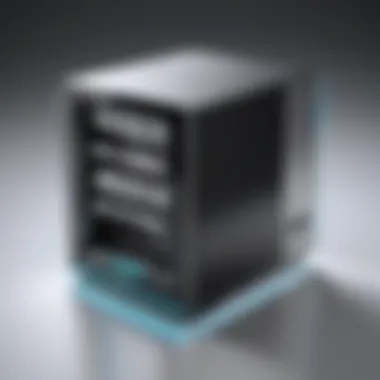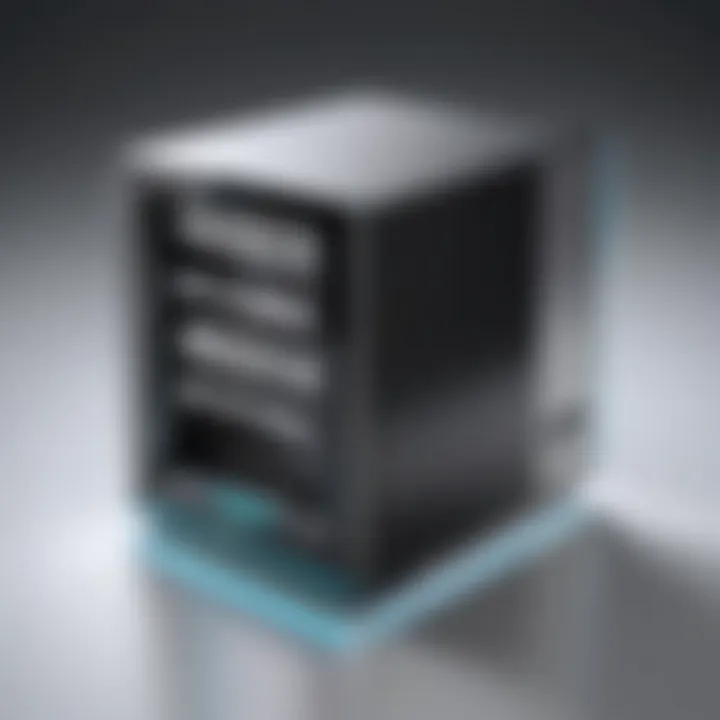Understanding DLP Appliances: A Comprehensive Overview


Intro
Data Loss Prevention (DLP) appliances have become integral to contemporary data security measures. As organizations increasingly rely on digital information, safeguarding sensitive data has transitioned from a secondary concern to a fundamental necessity.
DLP appliances serve to monitor, detect, and prevent data breaches, ensuring that critical information remains protected. They are not just tools but crucial elements in a broader data protection strategy, addressing various challenges faced by companies today. This article delves into the intricacies of DLP appliances, their purpose, key features, and challenges organizations encounter with data security.
Overview of Software
Purpose and Use Cases
DLP appliances primarily aim to protect sensitive data from unauthorized access and breaches. They achieve this by enforcing policies that monitor and control data transfer, whether that occurs internally within an organization or externally across networks.
Common use cases for DLP appliances include:
- Regulatory Compliance: Organizations in sectors like finance or healthcare must adhere to strict regulations regarding data privacy. DLP appliances help ensure compliance with laws such as GDPR or HIPAA.
- Insider Threat Protection: Employee negligence or malice can lead to data leaks. DLP solutions can track user activity and flag unusual behavior.
- Intellectual Property Protection: Companies invest heavily in research and development. DLP appliances can safeguard trade secrets and proprietary information from theft.
Key Features
Understanding the key features of DLP appliances can help organizations select the right solution for their needs. These features often include:
- Content Inspection: This allows the system to analyze data content across various platforms to identify sensitive information.
- Policy Management: Organizations can define specific rules regarding data usage and sharing, adapting them as necessary.
- Real-Time Monitoring: DLP solutions provide continuous surveillance of data transfers, enabling immediate detection of potential breaches.
In-Depth Review
Performance Analysis
For organizations utilizing DLP appliances, performance is a critical consideration. The efficiency of these systems can significantly impact an organization's data security strategy. Appliances must integrate seamlessly with existing systems without causing disruptions. Evaluating their performance can involve metrics such as:
- Detection Rate: How effectively does the appliance identify sensitive data?
- False Positive Rate: Is the appliance prone to incorrect alerts that could lead to unnecessary investigation?
- Impact on System Performance: Does the appliance slow down network speed or user experience?
User Interface and Experience
A user-friendly interface can enhance the effectiveness of DLP appliances. Complex systems may lead to user errors or inadequate policy enforcement. Key aspects to consider in user experience include:
- Ease of Navigation: Can users easily find and understand settings?
- Dashboard Functionality: Do dashboards provide clear, actionable insights into data security status?
- Reporting Capabilities: Is data analyzed and presented in an understandable manner?
"A DLP appliance is most effective when its features are fully understood and utilized across the organization."
Through a targeted exploration of DLP appliances, organizations can better navigate the complexities of data protection. This comprehensive guide will equip them with valuable insights to implement effective DLP strategies that align with their specific needs.
Preface to DLP Appliances
Data Loss Prevention (DLP) appliances play a crucial role in the realm of information security. As organizations increasingly rely on digital data and cloud technologies, safeguarding this sensitive information becomes imperative. DLP appliances help protect data from unauthorized access and manage the flow of sensitive information across networks. Understanding these appliances is vital for IT professionals and organizations looking to enhance their security framework.
DLP solutions encompass various functionalities that allow for the identification, monitoring, and protection of sensitive data. These appliances can be deployed in different configurations, depending on the organization's specific needs. Moreover, the landscape of data threats continues to evolve, which necessitates a proactive approach to data security. Organizations must assess the type of data they handle and the potential risks involved.
Defining Data Loss Prevention
Data Loss Prevention refers to a set of strategies and tools designed to prevent data breaches and ensure that sensitive information does not leave a secure environment. DLP appliances utilize various methods to detect unauthorized data transmissions or potential leaks, protecting both personal and corporate data. They can identify sensitive information such as personally identifiable information (PII), financial records, or intellectual property.
A well-defined DLP framework involves strong configuration settings that address specific data security policies. This includes classifying data, identifying where it resides, and establishing rules governing its usage. Organizations that implement robust DLP measures are often better positioned to face regulatory compliance requirements and address internal vulnerabilities.
Importance of DLP in Modern Organizations
DLP appliances have gained significance due to numerous factors affecting modern organizations. With escalating data breaches and the growing complexity of cyber threats, having a proactive data security plan is vital. Here are some key reasons why DLP is crucial:
- Protection against Data Breaches: DLP appliances help mitigate the risks of data leaks and unauthorized data movement. This is essential to prevent potentially damaging breaches that could lead to financial losses and reputational decline.
- Regulatory Compliance: Many industries face stringent regulatory requirements regarding data protection. DLP solutions assist organizations in meeting these standards by ensuring that sensitive data is monitored and managed appropriately.
- Increased Visibility and Control: DLP technologies provide detailed insights into the movement and usage of sensitive data. This enables organizations to make informed decisions while managing their data assets effectively.
"In today's digital environment, organizations must take data protection seriously. DLP appliances offer essential tools for safeguarding valuable information and meeting compliance goals."
Overall, understanding digital threats and leveraging DLP technologies is not just beneficial but necessary for organizations striving to protect their most valuable asset—their data.
Types of DLP Appliances
Understanding the varieties of DLP appliances is crucial for organizations aiming to safeguard their sensitive data. Different types of DLP appliances serve unique functions and target various potential risks. This section examines the three primary types: Network DLP Appliances, Endpoint DLP Appliances, and Storage DLP Appliances. Each of these categories brings its own strengths and considerations, aligning with different parts of an organization’s data protection strategy.
Network DLP Appliances
Network DLP Appliances are positioned at the interstitial points of data traffic within an organization. These appliances inspect data as it moves across the network, protecting against unauthorized transmissions of sensitive information. The central role of these appliances is to monitor and manage data in motion, which is essential for preventing data breaches during transmission.
Key features include:
- Traffic Monitoring: Analyzing inbound and outbound data for sensitive content.
- Policy Enforcement: Enforcing security policies related to data transfers.
- Incident Response: Automatically responding to potential leaks by blocking or alerting.


The consideration for implementing network DLP is particularly relevant for businesses with substantial external data flow. A vital challenge to address is ensuring that legitimate business activities are not hindered by overly aggressive filtering. The balance between security and operational efficiency is critical.
Endpoint DLP Appliances
Endpoint DLP Appliances focus on individual devices, such as workstations and laptops. They protect sensitive data at the endpoints where data is generated or used. These appliances control access to sensitive information, track user activity, and provide encryption capabilities.
Features worth noting include:
- Data Encryption: Ensuring data is not exposed if the device is lost or compromised.
- User Activity Monitoring: Tracking user interactions to identify unusual behavior.
- Data Access Control: Implementing role-based access to ensure only authorized personnel can view sensitive data.
Organizations must weigh the need for such protection against potential usability issues. User experience can be impacted if too many restrictions are placed. A thoughtful approach to implementation will help to mitigate resistance from users while enhancing security.
Storage DLP Appliances
Storage DLP Appliances deal specifically with data at rest. They focus on safeguarding stored information against unauthorized access and potential leaks. By analyzing data repositories, they ensure that sensitive information is stored securely and complies with relevant regulations.
Essential characteristics include:
- Data Discovery: Identifying where sensitive data resides within storage systems.
- Policy Enforcement: Applying security policies on stored data and ensuring compliance.
- Data Classification: Classifying data to apply the correct level of security.
The challenge here often lies in managing existing data and ensuring that the classified data maintains its status over time. Organizations must consider how to effectively clean and classify data without introducing vulnerability into their systems.
A thorough understanding of the various types of DLP appliances enables organizations to tailor their data protection strategies to their specific needs, ensuring robust security while maintaining efficiency.
Key Features of DLP Appliances
Data Loss Prevention (DLP) appliances serve as a critical line of defense for organizations in their quest to protect sensitive information. To be effective, DLP appliances must have a range of features that enable them to monitor, detect, and respond to potential data breaches. Understanding these key features allows organizations to choose the right DLP solutions and employ them effectively.
Content Inspection Capabilities
Content inspection is a foundational element of DLP technology. This capability refers to the ability to analyze data at rest, in transit, or in use. It can occur across various channels, such as email, cloud storage, or endpoint devices. The DLP appliance scans files, emails, and other types of communications for sensitive data based on predefined rules and policies.
Organizations can define what constitutes sensitive data, typically including personally identifiable information (PII), financial information, healthcare records, intellectual property, etc. By doing so, DLP appliances can flag, block, or monitor the transmission of this data. The effectiveness of content inspection largely depends on the accuracy of the scanning algorithms and the comprehensiveness of the predefined policies.
Policy Enforcement Mechanisms
Policy enforcement mechanisms allow organizations to implement data protection strategies effectively. Once sensitive content is detected, a DLP appliance reacts according to the set policies. This can be a crucial aspect for compliance with industry regulations, such as GDPR or HIPAA.
Enforcement can include different actions, such as:
- Blocking the transmission of sensitive data: Preventing data from being sent outside the organization in case of unauthorized attempts.
- Quarantine: Temporarily isolating data for further inspection before taking any action.
- Alerting administrators: Notifying security personnel of potential breaches for manual review.
- Logging incidents: Keeping track of breaches to provide insights for future improvement.
Each organization should tailor its policies based on its data security needs, regulatory obligations, and risk assessment. The ability to enforce these policies seamlessly is a significant advantage of DLP appliances.
Incident Response and Reporting
When a data breach occurs or a policy violation is detected, it's essential for organizations to have a robust incident response framework in place. DLP appliances often come equipped with tools for immediate response and detailed reporting.
Incident response can involve:
- Automated actions to secure sensitive data, such as encryption or blocking transfers.
- Manual interventions by security teams when assessments require human judgment.
- Incident analysis: DLP solutions typically generate logs and reports that summarize incidents, enabling organizations to analyze trends and patterns over time.
Reporting capabilities also play a critical role in compliance audits. Detailed reports help demonstrate that data protection measures are in place and functioning. Thus, organizations can provide evidence of diligence in protecting sensitive information.
"Having a comprehensive incident response plan is just as crucial as the technology itself in ensuring data security."
In summary, the key features of DLP appliances, including their content inspection capabilities, policy enforcement mechanisms, and incident response functionalities, form the backbone of an effective data protection strategy. By understanding and leveraging these features, organizations can enhance their overall data security posture.
Benefits of Implementing DLP Appliances
Implementing Data Loss Prevention (DLP) appliances offers several pivotal advantages for organizations aiming to protect sensitive data. As cyber threats escalate, the need for robust data security measures becomes more pressing. DLP appliances not only help in defending against these threats but also deliver additional benefits that are fundamental in today's data-centric environment.
Enhanced Data Security
One of the most significant advantages of DLP appliances is enhanced data security. These appliances monitor and protect sensitive information from unauthorized access and data exfiltration. With the capability to inspect data across various channels such as emails, web traffic, and endpoints, DLP solutions can detect potential threats in real time. Organizations can customize rules and policies to identify sensitive data, such as credit card numbers or personal identifiers. This tailored approach significantly mitigates the risk of data breaches.
DLP appliances rely on advanced content inspection tools. This allows them to analyze the data's context and apply pre-defined security policies effectively. For instance, a DLP appliance can identify when sensitive data is being shared inappropriately and block the transaction or alert an administrator. This capability creates a stronger security posture for the organization, ensuring that data remains within the intended channels.
Regulatory Compliance
In a landscape where regulatory frameworks such as GDPR, HIPAA, and PCI DSS impose stringent requirements for data handling, implementing DLP appliances aids in achieving compliance. Organizations that deal with sensitive data must demonstrate due diligence in protecting that information. Failure to comply can result in hefty fines and damage to reputation.
DLP appliances assist in maintaining compliance by providing visibility into data flows and ensuring that sensitive information is properly managed according to the relevant regulations. The reporting features of these appliances allow organizations to generate audit trails and compliance reports easily. This documentation can be crucial during regulatory audits, showcasing the measures taken to protect sensitive data. By proactively managing data, organizations can effectively minimize legal risks and reinforce their commitment to data protection.


Risk Mitigation
Another vital benefit of DLP appliances is their role in risk mitigation. Data breaches not only entail immediate financial losses but also affect customer trust and long-term business sustainability. DLP solutions come equipped with features that predict and manage potential risks associated with data handling.
By analyzing user behaviors and data patterns, DLP appliances help organizations identify vulnerable areas within their data governance practices. For instance, if an employee habitually accesses sensitive information without proper justification, the system can flag this behavior for review. Early detection of such anomalies allows organizations to take corrective actions before an incident escalates into a breach.
Moreover, with the capability of seamless integration into existing security infrastructures, DLP appliances enhance the overall risk management framework. This holistic approach is essential as it ensures that both data protection and incident response strategies are aligned, contributing to a comprehensive risk mitigation strategy.
"Implementing DLP appliances is not just a technical necessity; it is a strategic move toward safeguarding organizational integrity in the digital realm."
Challenges in Managing DLP Appliances
Effective management of DLP appliances is critical for organizations aiming to safeguard sensitive data. Failure to address these challenges can undermine the security measures established. There are three primary issues that organizations must navigate: false positives and alert fatigue, integration with existing systems, and user resistance and compliance issues. Each of these elements can impact how well DLP appliances perform and how effectively they fit into a broader security framework.
False Positives and Alert Fatigue
False positives occur when DLP systems incorrectly identify safe data as a potential leak. This can happen due to overly broad policies or insufficiently refined algorithms. The consequences of false positives are significant. They lead to alert fatigue among security teams. When employees regularly encounter alerts that do not require action, their ability to respond effectively to genuine threats diminishes.
To mitigate this issue, organizations should strive for a balanced approach in setting DLP policies. Regularly reviewing and refining these policies can help minimize false alarms. This can involve a deep dive into historical incidents to understand what types of data leaks were actual threats and what was identified mistakenly. Ongoing training for security teams can also enhance their ability to discern real threats from false positives.
Integration with Existing Systems
DLP appliances must operate alongside a range of other security technologies. Integration can often be complex and challenging. Many organizations utilize various software and hardware systems, from firewalls to endpoint protection solutions. If a DLP appliance cannot integrate smoothly, its effectiveness is severely compromised.
To address this challenge, organizations must carefully evaluate DLP solutions based on compatibility with their existing infrastructure. They should seek vendors that support open APIs and have a strong history of successful integrations. Testing pre-deployment and exploring sandbox environments can also help identify potential issues early on.
User Resistance and Compliance Issues
DLP implementations can occasionally meet resistance from users. Employees might view these systems as intrusive or limiting their ability to perform daily tasks. This resistance can result in non-compliance, where users circumvent the measures in place.
To combat this, it is essential for organizations to foster an understanding of the value of DLP appliances. This can involve comprehensive training sessions outlining how DLP systems protect both the organization and the employees' personal data. Creating clear communication channels for reporting issues can also empower users and reduce fear or misconceptions regarding DLP technology.
Evaluating DLP Appliance Solutions
When selecting a Data Loss Prevention (DLP) appliance, evaluating solutions is critical. The risks of data breaches are profound, so organizations must choose solutions that fit their specific needs and threats. This evaluation process covers essential elements, such as performance, compatibility, and scalability. A systematic approach ensures that organizations do not invest in technologies that will not deliver expected security outcomes or that complicate existing systems.
Consideration of Business Needs
Understanding unique business needs is the first step in evaluating DLP appliance solutions. Each organization has different data protection requirements depending on industry, size, and regulatory considerations. For instance, a healthcare provider must comply with HIPAA, while a financial institution may focus on PCI DSS compliance. Identifying your organization's primary data protection objectives helps in narrowing down the appliance that provides the best fit. Key questions to ask include:
- What types of data does the organization handle?
- What are the primary risks associated with that data?
- Which regulations must the organization comply with?
Answering these questions can help highlight specific requirements such as the need for real-time monitoring, data encryption, or advanced threat detection. This tailored assessment forms the foundation of the evaluation process, ensuring that the chosen appliance effectively addresses organizational vulnerabilities.
Comparing Vendors
Once the business needs are clearly defined, the next step is to compare various DLP appliance vendors. This involves analyzing features, performance metrics, customer support, and overall reputation. Not all vendors are the same; some excel in specific areas but may fall short in others. Factors to consider during this comparison include:
- Feature Set: Does the vendor's solution offer the necessary functionalities for your organization? Consider features such as content scanning, policy enforcement, and reporting capabilities.
- Scalability: Will the solution grow with your organization? Check if the vendor offers scalable options as business needs expand.
- Integration Potential: Evaluate how easily the appliance will blend into existing IT ecosystems. It should collaborate effectively with current technologies to ensure seamless data flow and security.
- Vendor Reputation: Research the vendor's history and user experiences. Reading third-party reviews or forums can provide insights into their reliability and client satisfaction.
Pricing Models and Total Cost of Ownership
Price is an important consideration, but the focus should be on the total cost of ownership (TCO) over time. Understanding the pricing models offered by various vendors can prevent organizations from facing unexpected costs after purchase. When assessing pricing, consider:
- Initial Costs: These include purchase price or subscription fees.
- Implementation Costs: Account for expenses related to deploying the appliance. This may involve additional hardware, software, or integration services.
- Operational Costs: Continual costs like maintenance, support, and updates can add up. Look for clearly defined terms in the vendor's contracts to avoid hidden fees.
- Opportunity Costs: Consider the potential costs of data loss or breaches should the chosen appliance fail to meet protection needs.
Evaluating these aspects will facilitate informed decisions, ensuring that the selected DLP solution not only fits budget constraints but also effectively safeguards sensitive data.
"A well-chosen DLP appliance doesn't merely protect data; it aligns with the organization’s strategic goals, enhancing overall operational integrity."
A thorough evaluation and comparison process ultimately provides organizations with a clear view of which DLP appliance solution will deliver the best combination of security, compliance, and cost-effectiveness.
Implementation Strategies for DLP Appliances
Implementing Data Loss Prevention (DLP) appliances effectively is crucial for organizations keen on safeguarding sensitive information. A sound implementation strategy can maximize the protective features offered by these appliances. The focus here is on several key elements: policy creation, user training, and structured rollout processes.
Developing a DLP Policy Framework
A DLP policy framework serves as one of the foundational elements of any DLP implementation. It outlines what constitutes sensitive data and establishes guidelines for its handling, transmission, and storage. Organizations should start by identifying the types of data that are critical to their operation. This can include personally identifiable information, proprietary business information, and other forms of confidential data.
Once the sensitive data is identified, the next step involves defining the rules and regulations associated with data usage. This includes stipulating who can access the data and under which circumstances. To gain buy-in from all stakeholders, these policies should be articulated clearly and reviewed regularly to adapt to new threats or changes in the business environment.
User Training and Awareness Programs


User training is an often-overlooked component in the implementation of DLP appliances. Even the best technology can be undermined by human error. Therefore, it is vital to develop comprehensive training programs tailored to various user roles within the organization. Employees must understand the importance of data protection and the specific policies governing DLP initiatives.
Training should cover not only how to utilize DLP tools but also why these measures are necessary. Awareness programs emphasizing the consequences of data breaches can help foster a culture of security. Specific scenarios should be discussed to illuminate potential risks and proper behaviors. This can include how to spot phishing attempts, recognizing the importance of secure passwords, and understanding the implications of mishandling sensitive data.
Phased Rollout and Testing
A phased rollout approach can significantly benefit the implementation of DLP appliances. This method allows for incremental integration, facilitating easier identification of potential issues without the overwhelming potential of a large-scale rollout.
Beginning with a pilot program involving a small segment of the organization can provide valuable insights. Monitoring how the DLP appliance performs in this controlled environment allows for adjustments before wider deployment. Regular testing is equally essential. Whether through simulated data breaches or vulnerability assessments, consistent testing can confirm that policies are enforced effectively. Feedback from users during this phase can lead to enhancements that improve functionality and address any gaps.
Implementing DLP appliances is not a one-time project; it’s a continuous journey. Regular evaluations and updates are critical to maintaining effectiveness.
In summary, the importance of strategic implementation of DLP appliances cannot be overstated. By developing a strong policy framework, emphasizing user training, and adopting a phased rollout approach, organizations can enhance their defenses against data breaches and ensure compliance with regulatory requirements.
Case Studies of DLP Appliance Implementations
When exploring Data Loss Prevention (DLP) appliances, analyzing actual cases can provide crucial insights. Case studies of DLP appliance implementations illustrate how organizations adopt these tools to safeguard sensitive information. They reveal the practical challenges organizations face and the solutions offered by DLP systems. By assessing these real-life implementations, companies can learn about the strategic planning, execution, and results associated with deploying DLP solutions.
Additionally, these case studies demonstrate the versatility of DLP appliances across different sectors. They show how various industries tailor DLP strategies to their unique requirements. This understanding helps decision-makers consider how DLP appliances can effectively address their own data security needs.
Success Stories in Various Industries
Success stories offer compelling evidence of the effectiveness of DLP appliances. For instance, companies in finance often implement DLP to comply with regulations like PCI DSS, protecting customer payment information. In this context, a bank might utilize McAfee's Total Protection for Data Loss Prevention to monitor sensitive transactions in real-time. The results often show significant reductions in data breaches and enhanced customer trust.
Moreover, companies in healthcare leverage DLP systems such as Symantec Data Loss Prevention to secure patient records. These organizations report increased compliance with HIPAA regulations, illustrating how DLP is essential in protecting patient privacy.
Retailers, too, recognize the value of DLP appliances. A notable example is Target, which faced significant data breaches in the past. Following these incidents, the company implemented DLP solutions to monitor their networks and prevent unauthorized data access. Post-implementation assessments indicate that Target was able to strengthen its data security posture significantly.
Lessons Learned from Failed Implementations
Not all DLP appliance implementations yield positive results. Some organizations struggle due to inadequate planning or lack of user training. Common failures often stem from overly complex policies that overwhelm users rather than guiding them. For instance, a tech company might implement a DLP solution without proper integration into existing workflows, resulting in user resistance and low effectiveness.
Additionally, budget constraints can lead to choosing subpar solutions or insufficient resources for training and support. In one case, a financial institution opted for a less expensive DLP appliance, which lacked necessary features to meet regulatory standards. Consequently, they faced penalties and reputation damage due to persistent data leaks.
"Implementing DLP is not merely about installing a system; it requires a holistic strategy that encompasses policy creation, user awareness, and continuous monitoring."
These lessons underscore the importance of aligning DLP strategies with organizational objectives. By evaluating both successes and failures, companies can craft more effective DLP implementations that fulfill their specific security needs. They highlight the necessity of continuous training and policy adjustment to meet the evolving landscape of data security.
Future Trends in DLP Technology
Data Loss Prevention (DLP) technology is continually evolving to address the dynamic risks faced by organizations. As businesses adopt more complex infrastructures and face increasing data breaches, keeping ahead of these trends is essential. Understanding future trends in DLP technology enables organizations to enhance their strategies for protecting sensitive information.
Machine Learning and AI Integration
The integration of Machine Learning (ML) and Artificial Intelligence (AI) into DLP solutions is a significant trend reshaping how organizations manage data security. ML algorithms analyze vast datasets to identify patterns, which helps in classifying sensitive information more effectively. As a result, these technologies can reduce the instances of false positives that often plague DLP systems.
Furthermore, AI-driven DLP systems learn from historical data breaches and user behavior, adapting to new threats in real-time. This adaptability ensures that organizations can respond swiftly to emerging risks, making the systems not only proactive but also predictive.
- Enhanced pattern recognition capabilities o Improved incident response times
- Continuous learning from new data
Cloud-Based DLP Solutions
As businesses shift towards cloud computing, the demand for cloud-based DLP solutions is growing. Traditional DLP appliances were primarily designed for on-premises data, but with more organizations storing sensitive information in the cloud, there is a pressing need for DLP strategies that are cloud-centric.
Cloud-based DLP solutions facilitate
- Centralized management of data security across multiple platforms.
- Real-time monitoring that adapts to the cloud environment.
- Scalability, allowing organizations to expand their security measures as they grow.
Organizations must ensure that their chosen cloud DLP solutions comply with various regulations, helping to meet data protection standards globally.
"The integration of AI in DLP technology represents a shift towards more autonomous systems capable of self-optimizing based on real-world data."
Organizations looking to implement future DLP strategies should consider these trends seriously. They are not just options; they are becoming necessities in creating a safe and compliant data environment.
Culmination on the Role of DLP Appliances
The role of Data Loss Prevention (DLP) appliances has become vital in the context of contemporary data security. Organizations are increasingly recognizing the need for mechanisms that can safeguard sensitive information from unauthorized access, data breaches, and unintentional exposure. DLP appliances serve as a crucial layer of defense across various domains, ranging from enterprise networks to individual endpoints.
One significant element of DLP appliances is their ability to monitor and manage data movement. These tools help to identify potential risks by analyzing data at rest, in use, and in transit. By doing so, organizations can enforce policies that dictate how and where sensitive data can be shared. This policy enforcement is essential in ensuring compliance with regulations such as GDPR and HIPAA, which mandate strict controls over personal and sensitive information.
DLP appliances are not just about prevention. They also provide incident response capabilities, enabling organizations to react swiftly to potential threats. This involves generating detailed reports and alerts, which facilitate investigation and remediation processes. Understanding how these appliances contribute to incident response enhances an organization’s overall security posture.
Benefits and Considerations
- Enhanced Security: DLP solutions minimize the risks of data leaks, thereby protecting the organization's reputation and finances.
- Regulatory Compliance: As mentioned previously, adhering to relevant laws is crucial, and DLP helps maintain that compliance.
- User Education: Effectiveness of DLP appliances often relies on user awareness. Training programs are essential to ensure all employees understand their role in protecting data.
It is also noteworthy that while DLP appliances are effective, they may present challenges such as false positives and the need for integration with existing systems. Organizations must have a strategy to address these challenges to maximize the benefits of DLP solutions.
In summary, the implementation of DLP appliances not only protects sensitive data but also aligns with broader data governance initiatives. By investing in these technologies, organizations prepare themselves to face the evolving landscape of data security threats.







